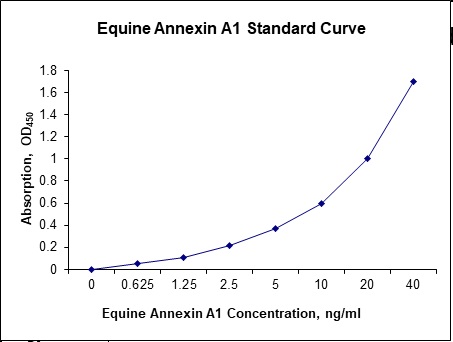Nori Equine Annexin A1 ELISA Kit
$461.00 – $832.00
This ELISA kit is for quantification of ANXA1 in horse. This is a quick ELISA assay that reduces time to 50% compared to the conventional method, and the entire assay only takes 3 hours. This assay employs the quantitative sandwich enzyme immunoassay technique and uses biotin-streptavidin chemistry to improve the performance of the assays. An antibody specific for ANXA1 has been pre-coated onto a microplate. Standards and samples are pipetted into the wells and any ANXA1 present is bound by the immobilized antibody. After washing away any unbound substances, a detection antibody specific for ANXA1 is added to the wells. Following wash to remove any unbound antibody reagent, a detection reagent is added. After intensive wash a substrate solution is added to the wells and color develops in proportion to the amount of ANXA1 bound in the initial step. The color development is stopped, and the intensity of the color is measured.
Alternative names for ANXA: Annexin A1
This product is for laboratory research use only, not for diagnostic and therapeutic purposes or any other purposes.
- Description
- How Elisa Works
- Product Citation (0)
- Reviews (0)
Description
Nori Equine ANXA1 ELISA Kit Summary
Alternative names for ANXA1: Annexin A1,
Alternative name for equine: Horse
| Assay Type | Solid Phase Sandwich ELISA |
| Format | 96-well Microplate or 96-Well Strip Microplate |
| Method of Detection | Colorimetric |
| Number of Targets Detected | 1 |
| Target Antigen Accession Number | Q8HZM6 |
| Assay Length | 3 hours |
| Quantitative/Semiquantitative | Quantitative |
| Sample Type | Plasma, Serum, Cell Culture, Urine, Cell/Tissue Lysates, Synovial Fluid, BAL, |
| Recommended Sample Dilution (Plasma/Serum) | No dilution for sample <ULOQ; sufficient dilution for samples >ULOQ |
| Sensitivity | 120 pg/mL |
| Detection Range | 0.625-40 ng/mL |
| Specificity | Natural and recombinant equine annexin A1 |
| Cross-Reactivity | < 0.5% cross-reactivity observed with available related molecules, < 50% cross-species reactivity observed with species tested. |
| Interference | No significant interference observed with available related molecules |
| Storage/Stability | 4 ºC for up to 6 months |
| Usage | For Laboratory Research Use Only. Not for diagnostic or therapeutic use. |
| Additional Notes | The kit allows for use in multiple experiments. |
Standard Curve
Kit Components
1. Pre-coated 96-well Microplate
2. Biotinylated Detection Antibody
3. Streptavidin-HRP Conjugate
4. Lyophilized Standards
5. TMB One-Step Substrate
6. Stop Solution
7. 20 x PBS
8. Assay Buffer
Other Materials Required but not Provided:
1. Microplate Reader capable of measuring absorption at 450 nm
2. Log-log graph paper or computer and software for ELISA data analysis
3. Precision pipettes (1-1000 µl)
4. Multi-channel pipettes (300 µl)
5. Distilled or deionized water
Protocol Outline
1. Prepare all reagents, samples and standards as instructed in the datasheet.
2. Add 100 µl of Standard or samples to each well and incubate 1 h at RT.
3. Add 100 µl of Working Detection Antibody to each well and incubate 1 h at RT.
4. Add 100 µl of Working Streptavidin-HRP to each well and incubate 20 min at RT.
5. Add 100 µl of Substrate to each well and incubate 5-30 min at RT.
6. Add 50 µl of Stop Solution to each well and read at 450 nm immediately.
Background:
Annexin A1 (ANXA1), also known as lipocortin I, is a protein that is encoded by the ANXA1 gene.[1] ANXA1 belongs to the annexin family of Ca2+-dependent phospholipid-binding proteins that are preferentially located on the cytosolic face of the plasma membrane. ANXA1 protein has an apparent relative molecular mass of 40 kDa with phospholipase A2 inhibitory activity. The main mechanism of glucocorticoids’ anti-inflammatory effects is to increase the synthesis and function of ANXA1.[2] ANXA1 suppresses phospholipase A2, thereby blocking eicosanoid production, and inhibits various leukocyte inflammatory events. In resting conditions, immune cells contain high levels of ANXA1 in their cytoplasm. Following cell activation (for example, by neutrophil adhesion to endothelial-cell monolayers), ANX1 is promptly mobilized to the cell surface and secreted. Annexin A1 promotes neutrophil detachment and apoptosis, and phagocytosis of apoptotic neutrophils by macrophages. On the other hand, it reduces the tendency of neutrophils to penetrate the endothelium of blood vessels. In vitro and in vivo analyses show that exogenous and endogenous ANXA1 counter-regulate the activities of innate immune cells, particularly extravasation and the generation of proinflammatory mediators, which ensures that a sufficient level of activation is reached but not exceeded.[2] ANXA1 has important opposing properties during innate and adaptive immune responses: it inhibits innate immune cells and promotes T-cell activation. The activation of T cells results in the release of annexin A1 and the expression of its receptor. Higher expression of ANXA1 during pathological conditions could increase the strength of TCR signaling through the mitogen-activated protein kinase signaling pathway, thereby causing a state of hyperactivation of T cells.[2] Since phospholipase A2 is required for the biosynthesis of the potent mediators of inflammation, prostaglandins, and leukotrienes, ANXA1 may have potential anti-inflammatory activity. Glucocorticoids stimulate production of lipocortin.[3] In this way, synthesis of eicosanoids are inhibited.
References
- Wallner BP, et al. (1986). Nature. 320(6057): 77–81.
- Perretti M, D’Acquisto F (2009). Nat. Rev. Immunol. 9 (1): 62–70.
- Peers SH, et al. (1993). British Journal of Pharmacology. 108 (1): 66–72.
Be the first to review “Nori Equine Annexin A1 ELISA Kit”
You must be logged in to post a review.




























Reviews
There are no reviews yet.